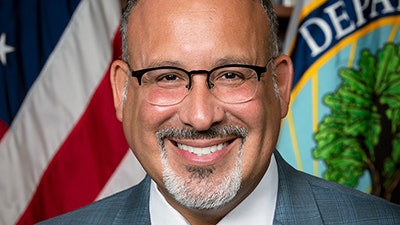The U.S. Department of Education (ED) has updated how it calculates the amount of aid students will receive to be in full alignment with the FAFSA Simplification Act.
U.S. Secretary of Education Dr. Miguel A. Cardona said the update, the latest in ED’s 2024–25 Better FAFSA® implementation, will not impact implementation timelines.
 Dr. Miguel Cardona
Dr. Miguel Cardona
Following are steps ED is taking to further improve the Better FAFSA® implementation:
1.) As part of the final steps in preparing to process FAFSA forms in the first half of March, ED updated how it calculates the amount of aid students will receive to be in full alignment with the FAFSA Simplification Act.
Officials said the update will not affect ED’s timeline for delivering completed applications to schools in the first half of March, and combined with other implementation efforts, the department’s Better FAFSA will result in 7.3 million students in total expected to be eligible for Pell Grants in the 2024–25 award year. Since the new 2024–25 FAFSA form became available Dec. 30, more than 4.7 million forms have been successfully submitted.
ED plans to work with colleges and vendors to put the update into effect in the coming days. It plans to be available to provide technical support and assistance to institutions through its FAFSA College Support Strategy. Under this strategy, ED is deploying federal personnel, allocating $50 million in technical assistance and support, and providing tools to help schools prepare to process student records as efficiently as possible.
2.) ED plans to deploy support from the office of Federal Student Aid and nonprofit organizations to lower-resourced colleges as part of its FAFSA College Support Strategy. These personnel will conduct needs-assessments and provide dedicated help to schools that are preparing for, and processing, student aid offer packages.
ED has received inquiries from over 100 institutions through the Concierge Service and has already followed up with these colleges to identify the specific needs for each institution. The department has also started proactively reaching out to additional colleges with high Pell enrollment, resource constraints, and other needs to offer support based on their needs.
3.) Officials said ED will send system-generated test student records (Institutional Student Information Records, or ISIRs) to schools and their vendors to process student records faster and more efficiently. System-generated test ISIRs are an important step in ensuring schools and their vendors can finalize their systems to process student records when they begin receiving them in the first half of March. This action builds on the test ISIRs shared with colleges earlier this month. ED will continue to update additional test ISIRs and open-source tools stored in a public department repository leading up to the processing date.





















